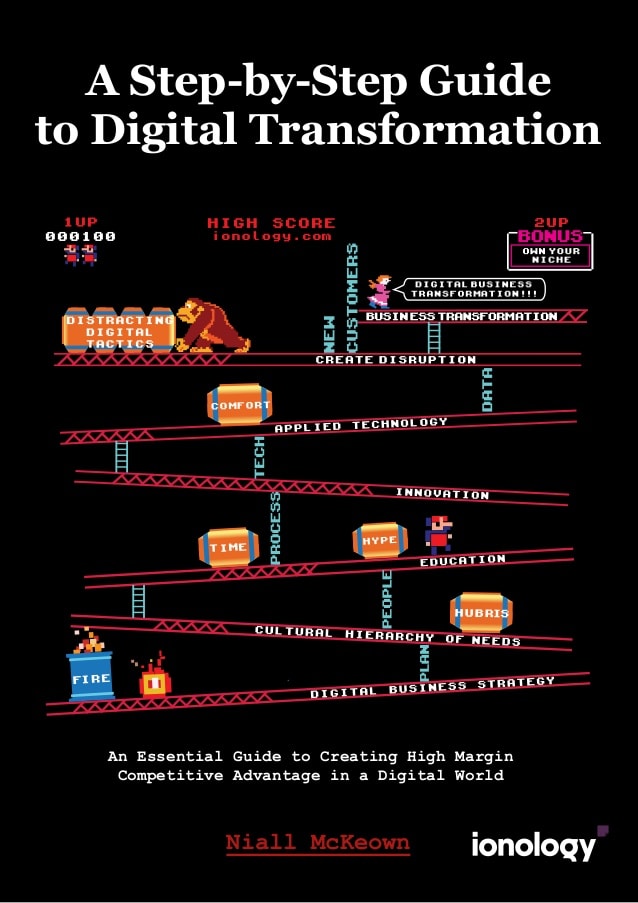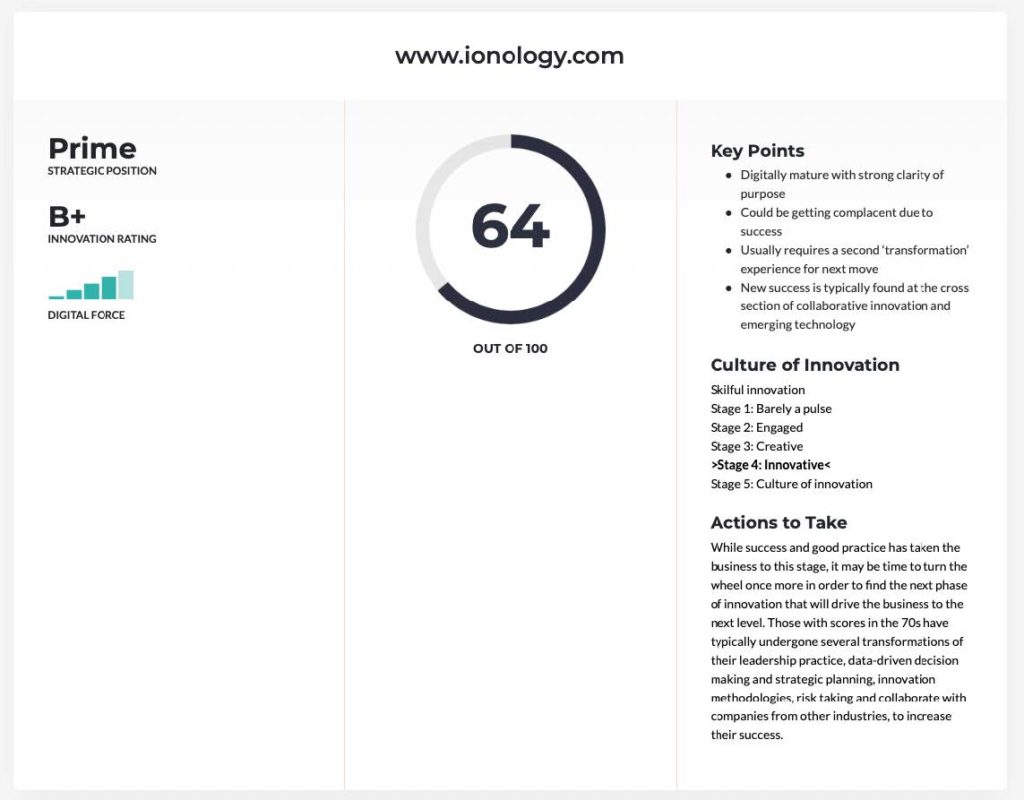What is a Digital Transformation Strategy?
A Digital Transformation Strategy is a plan of action describing how a business must strategically reposition itself in the digital economy. As customer habits change so do the way winning businesses operate. They innovate, change operating and business models and leverage emerging technology.
- What is a Digital Transformation Strategy? »
- What is a Digital Business? »
- How to make a Digital Transformation Strategy? »
- Digital Transformation Strategy in 2020 »
- Where to Start with a Digital Transformation Strategy »
- Who should be involved in creating a Digital Transformation Strategy? »
- What happens to businesses that don’t have a Digital Transformation Strategy? »
- What are the top 5 Digital Transformation Strategy Frameworks? »
- How do I measure if my Digital Transformation Strategy is working? »
For the technology industry perspective, a digital transformation strategy typically means the use of technology to complete tasks once manual. The challenge with this concept is that businesses have used technology to improve how they deliver their products and services since the dawn of commerce. Why is it now considered strategic and transformational?
From the creative industry perspective, digital transformation strategy is discussed through the lens of digital marketing and user experience (Ux). The idea that customers now utilise technology to research, find and select products and services that match their needs. While this is true, building a website, an app or e-commerce strategy is hardly transformational.
From the management consultants perspective, they see digital transformation as an opportunity to reshape a business. To align the operating model with new business models. The product and services of a business can, if considered in the right way, become more digitally infused. This reduces the operating cost and increases profit.
So who is right? All of them are right to a certain degree. To create a digital transformation strategy needs technology as the tools used to create a transformed business. It requires the creative industry to express the new value produced in a way customers admire. It requires a management consultancy to help build a more efficient business. But one person is missing…
You! You need to change. Technology doesn’t change a business, you do, leveraging technology. Management consultancies don’t improve your business. You do by distilling their advice into action. Creative professionals can only express the differentiation you create. The starting point to creating a winning digital transformation strategy is to transform yourself.
It is unfair and potentially arrogant to assume that what created your success is all that’s needed to continue. Creating a digital transformation strategy is radically different from creating a business-as-usual strategy. The business ambition is not to upgrade its digital activities. It’s setting out to transform!
Before diving into digital transformation strategy, let’s get precise on what a digital business is.
Check out our Digital Transformation Courses
What is a Digital Business?
A digital business is a smart, adaptable, innovative organisation that can compete in the digital economy. Digital businesses reinvent rather than enhance or improve whatever is already in existence. They look at the world through virtual reality goggles, see new possibilities and are geared up to making things happen without causing a world of pain.
When we look at these businesses, they usually have some shiny, fancy techie ‘stuff’ of some description. We may be tempted to think that therein lies the secret to their success.
Au contraire.
Look beyond the sheen and what do you see?
I bet it’s a brilliant solution to a problem you might not even have known existed.
That fancy shiny stuff is a result of good old fashioned groundwork.
They’re like Magyver but with way cooler gadgets.
Digital businesses are not more imaginative or creative than anyone else. They are very good at doing their homework and they’ve got their strategy right. They have taken the time to really understand their customers and worked hard to develop solutions to their customers’ problems.
These businesses have leaders who have accepted it is their responsibility to lead their transformation, not the technologist, not the management consultant – the leader, taking them from business leader to digital leader.
Ok, so we’ve established what a digital transformation strategy is, we’ve distinguished what a digital business is, who needs to be involved and of course – who needs to lead this change. Now for the nitty gritty…
How to make a Digital Transformation Strategy
In 1996 Michael Porter, the Harvard Lecturer wrote an article in HBR called What is Strategy? In it, he argues that operational effectiveness, although necessary to superior performance, is not sufficient, because its techniques are easy to imitate. Richard Rumelt is an Emeritus Professor of Business and Society at UCLA Anderson School of Management. Described by McKinsey as “Strategy’s Strategist’. In his 20011 book Good Strategy/Bad Strategy, he reinforces that a strategy is not a goal or objectives. It is the battle plan for action that is designed upon a unique set of attributes or conditions (kernels) that sets an organization apart from its competitors (leverages) and results in exceptional and sustainable profits.
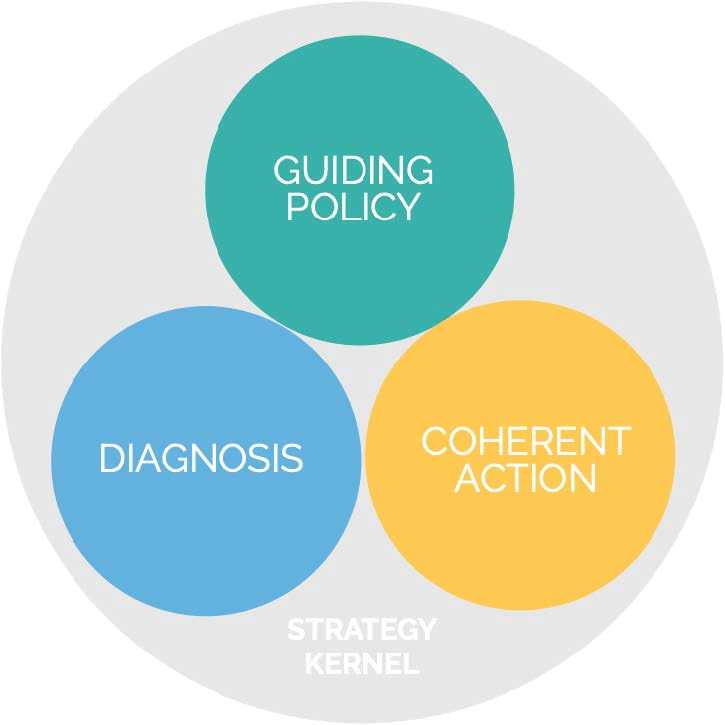
Digital Transformation Strategy
Good Strategy
Rumelt tells us that a good strategy has 3 components:
1. Diagnosis
2. Guiding Policy
3. Coherent Plan of Action.
(For more detail on Rumelts Digital Transformation Strategy Kernel, check out this no nonsense book review; Richard Rumelt – “Good Strategy. Bad Strategy”.)
Bad Strategy
From the organisations we’ve worked with, it’s quite common to see any one of these 3 components missing. Skipping these steps manifest themselves in many ways – but the outcomes for the organization eerily common. Let’s take a look at the pitfalls associated with each component.
What happens if you skip diagnosis?
Random acts of digital, unrealistic desired outcomes, mayhem, uncertainty.
People stabbing in the dark hoping to find something that will yield positive results. You might see isolated parts of the business becoming more ‘digital’. Technology is implemented but people don’t use it, scattered projects are underway but they don’t link to anything tangible, people don’t really understand what they’re doing or how to evaluate efforts.
Best case scenario is improved operational efficiency. Worst case scenario is frustration, complication, and wasted resource.
Either way there is no transformation, just digitised versions of the same processes, products and services.
The aim of the diagnosis phase is to understand the existing situation and the challenges that must be overcome in order to reach a desirable new situation — it gives tremendous clarity and helps keep things on track.
What happens if there is no guiding policy?
In most cases, the business will not meet its strategic objectives. If they are, it’s due to sheer good luck rather than good guidance. Without guiding policy a strategy is little more than a wishlist.
How do you identify a strategy without a guiding policy?
By asking one question — how do you want me to do that exactly?
If you can hear tumbleweed blowing through the corridors you know you have hit the spot.
A note of caution: beware the misguiding policies that might have you wandering up the garden path. How can you tell a guiding policy from a misguiding policy? Well if competitive advantage comes from differentiation a good guiding policy will contain some kind of ‘if this, then that’ statement. If your guiding policy can be applied to any organisation at any time and under any circumstances it probably isn’t all that helpful.
What happens if you don’t have a coherent plan of action?
Not a lot.
Sometimes people go straight back to work and carry on with business as usual. Sometimes people work around the clock and get nowhere. (The phrase headless chickens springs to mind.)
Ultimately it leads to wasted resources — waste of time, effort and investment.
Sadly, this eventually ends in disenfranchised, disheartened, burnout staff.
Nobody wants that.
The good news:
Now that we know what the problem is, we do can something about it.
Not sure where to start with your Digital Transformation Strategy?
Check out our Courses for Government & Enterprise
Digital Transformation Strategy in 2020
Fast forward to 2020 and the digital economy is flourishing. How customers, suppliers, products and services are sought, influenced and constructed, has changed. Anything that can be digitised, is being digitised. However, simply digitising existing products and services isn’t enough. It violates Porter’s and Rumelt’s philosophies.
Porter would claim that simply digitising that which already exists is operational effectiveness. He suggests it should be done, but it’s not a strategy. Rumelt would claim that a business should have a vision but that the strategy should be three months in length. It should be thought of as a continuous set of actions that provide insight through diagnosis, guidance and coherent action.
Many businesses mistake a to-do list as a strategy. Operational plans, resource plans or capital investment is thought of as strategic. While important, they’re not considered strategic by either Rumelt or Porter.
A digital transformation strategy is a plan of action to reposition a business in the digital economy. Data allows us to find new opportunities much more easily. Building a business that can leverage emerging technology and ride new opportunities with speed skill and determination, often requires a transformed way of working.
“True transformation isn’t top-down or bottom-up“ claims author Greg Satell in his book Cascades. “It’s side-to-side.”
“Change never happens all at once and can’t simply be willed into existence. It can only happen when people truly internalize and embrace it. The best way to do that is to empower those who already believe in the change to bring in those around them” says Satell.
Ionology has created the most advanced digital transformation framework in the world. “Most businesses say they want to change but their actions say otherwise.” Says Professor Niall McKeown, CEO of Ionology.
“Porter and Rumelt’s philosophy on strategy has never been more important. How we find the new opportunities they often talk about, however, has changed. This is why we need data-driven digital transformation frameworks and those with expert skills to guide their business through change”.
This video is an intense review of the Ionology framework (7 Principles of Digital Business Strategy). In a thrilling case study, it illustrates how to use frameworks to manage the process of digital transformation strategy creation.
Where Do I Start With My Digital Transformation Strategy?
Where do insights come from? The Large Hadron Collider is the world’s highest-energy particle collider and the largest machine in the world. The machine studies the smallest known elements in the universe, sub-atomic particles. Sometimes we need to zoom-out and look at the large mechanics that govern business. Sometimes we zoom-in and look at the detail. Both go hand-in-hand.
In the zoom-out/zoom-in metaphor, we can consider the 5 Change Blocks of Digital Transformation as the zoom-out. Finding opportunity in data is the zoom-in equivalent. It’s possible to start at the macro and micro level as the Digital Transformation Strategy video shows.
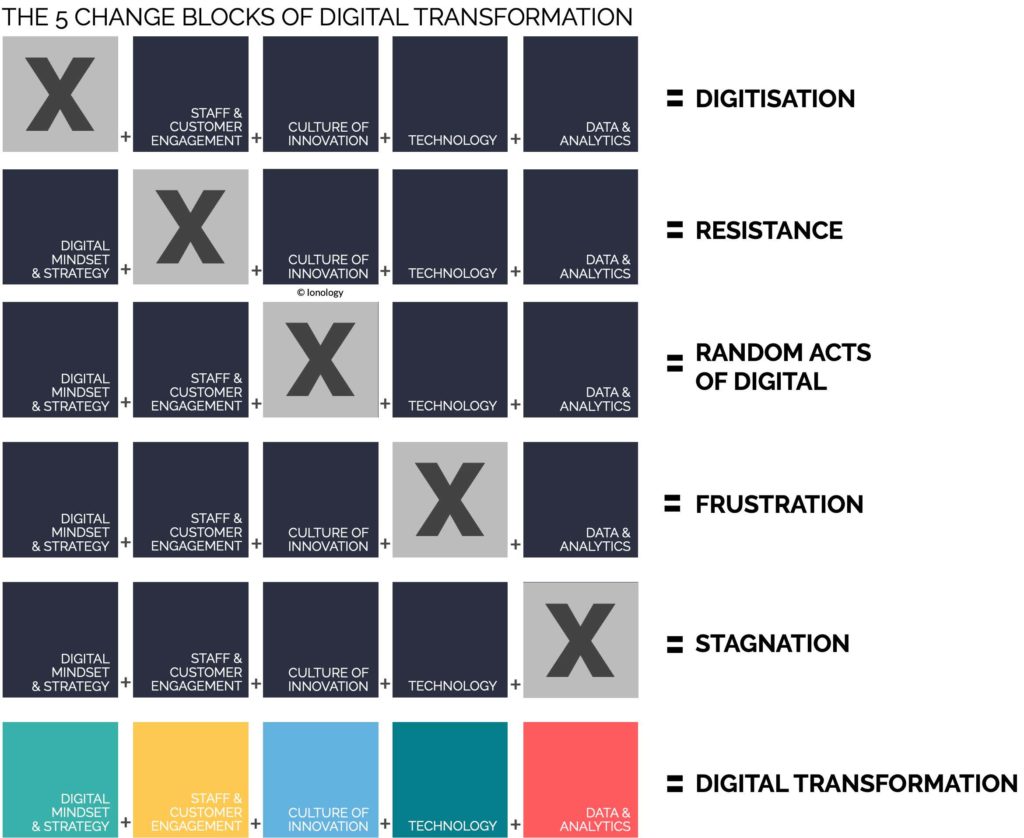
The 5 Change Blocks of Digital Transformation
Strategy
Strategy is but one part of creating a digitally transformed organisation. This sounds like I’m selling something. Trying to get you to buy more than you need. I promise this is not the case. All of the change blocks are a requirement and of course, strategy and technology are the two obvious components. However, having a good strategy and the right technology leads to digitising, not transforming.
A digital transformation strategy created by a team that has the right digital mindset will result in a very different plan of action from those that have the traditional business mindset. The interplay between mindset and strategy is fundamental. This is why they are contained as a single unit in the 5 Change Blocks of Digital Transformation.
Communications
Creating a digital transformation strategy requires that we understand how to communicate the changed state and the value it creates. If we fail to convince customers of the value they won’t buy. If we fail to convince our internal teams, they won’t shift!
If the change is minimal, it’s unlikely to be transformational, not going far enough. It’s not uncommon to test the value of the new transformed state by creating a ‘business of the future’ document or video. It explains what the business is transforming into. If the customer shrugs, it will be a long journey. If full support isn’t given by the leadership team, it just won’t happen.
Culture of Innovation
A digital transformation strategy must address innovation. The ultimate goal is to create a culture of innovation. This is easier said than done. Creativity needs to be nurtured. Like an artist learns to paint over time, so too does innovation talent mature from practice.
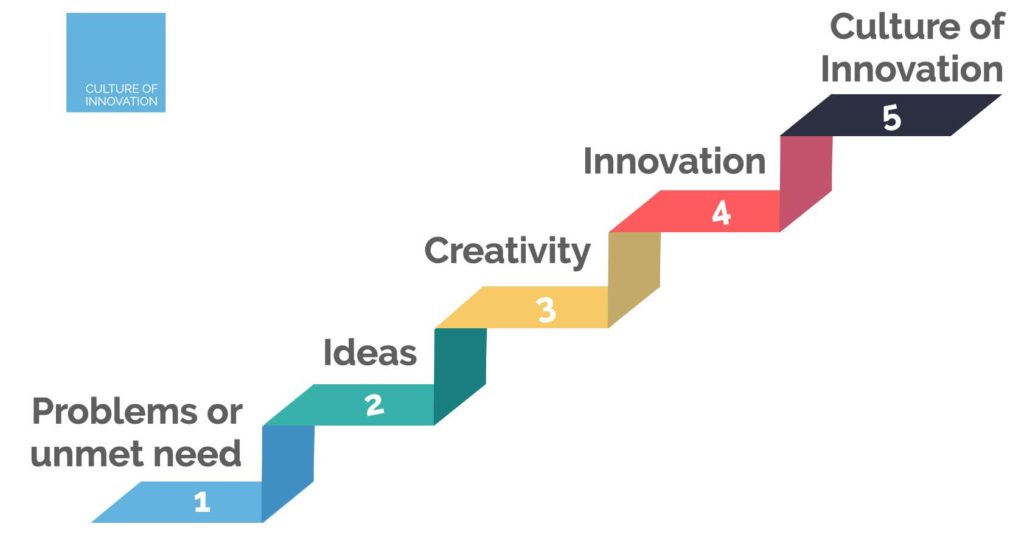
Good Ideas Are Not Good Enough
Many businesses mistake good ideas as innovation. They purchase proven technology and implement it claiming to have transformed their business. What they’ve usually done is made it more efficient. While this is a worthy pursuit, it doesn’t create lasting competitive advantage, it’s not strategic and this kind of marginal gain has been happening since the business was born. It is not transformational.
The strategy should have a list of diagnosed ‘unknowns’. The unknowns create experiments. These experiments create insights. The insights lead to innovations. Innovations are not one-time-shots or blue-sky thinking. It’s not the creation of an app although that may be necessary to simply maintain business as usual.
Innovation starts with a customer pain, problem or unmet need. The strategy focuses on identifying pain or unmet need. The communications will focus on articulating that need. Creativity will bring the best ideas to solving that need, through deliberate processes of innovation. Technology will be used to solve that need and data to measure its success.
A culture of innovation means that the business is capable of doing the above, systematically.
Technology
“We always overestimate the change that will occur in the next two years and underestimate the change that will occur in the next ten. Don’t let yourself be lulled into inaction.” – Bill Gates
Imagine a pilot announced “It’s time to take off. Strap in while I turn on the blowing machines that are stuck to the wings. I’m not sure what they do but don’t worry, I have an engineering team that does.” We wouldn’t stay on that plane for too long. We would look for the exit.
Yet this low standard of technical understanding is common among leaders, managers and decision-makers. New business models enabled by AI, Blockchain and IoT are a bigger threat to most businesses than compliance and financial mismanagement. In the boardroom, it would be unthinkable to abandon all fiscal and legal responsibilities, claiming the finance and legal departments have it covered. So why is it acceptable to do so with technology?
Technology is the tool that is inspiring innovators and enabling new business models. Leaders, managers and decision-makers have a compelling reason to understand the business capabilities of emerging technology. Like the pilot, we don’t expect them to understand how to change the fuel pump on the jet engine. They are expected to understand the capabilities of the engine if they are to take off and land safely. The same thing goes for non-technical executives wanting to lead a business through digital transformation.
Data
Which comes first, the chicken or the egg? This conundrum is designed to lead to a circular argument. There is no right answer. Replace the chicken with “data” and the egg with “business problem”. Does the data identify the business problem or does the business problem identify the data needed to solve it?
The answer is to start with the business problem, not the data. The chicken/egg metaphor doesn’t work in this instance. The business problem should come before the data. This is not a circular argument.
And where do the business challenges come from? They come from the digital transformation strategy. The process of diagnosis, guiding policy and coherent action helps identify the ‘unknowns’. From there the process of innovation and the implementation of emerging technology is submerged in data. If the chicken was the innovation, the egg would be the technology, data the yolk.
Would you like to learn more on how Ionology can help with your Digital Transformation Strategy?
Visit Digital Transformation Executive Education
Who should be involved in creating a digital transformation strategy?
There are many skills required to transform a business. Creative, leadership, technical, empathy and more. The three most important legs to the stool.
They are
- The Communications professional
- The Technologist
- The Leader.
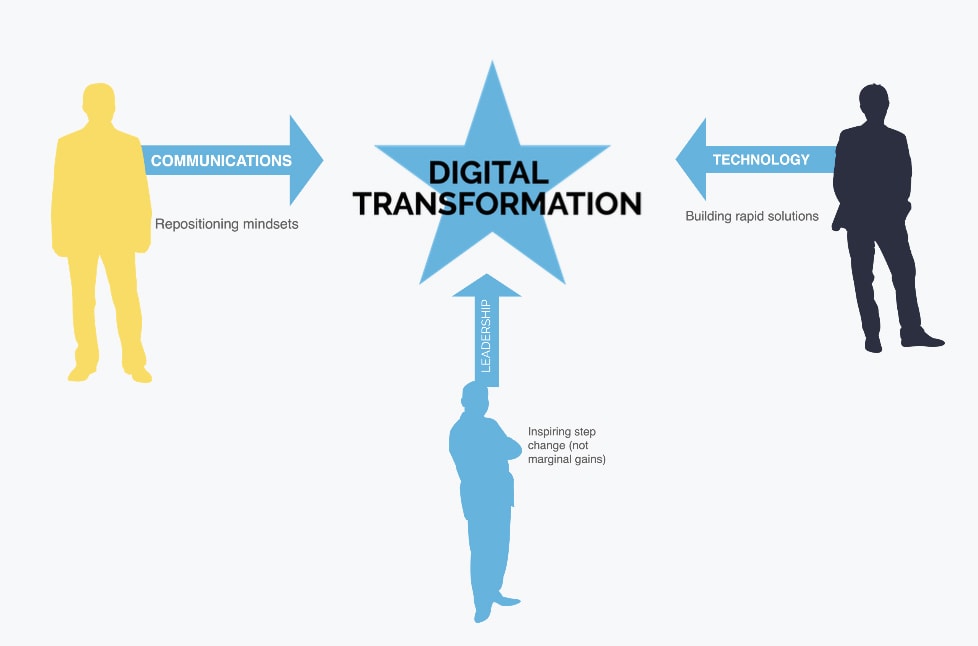
Who is involved in Digital Transformation Strategy?
The 3 Core Groups Involved in Creating a Digital Transformation Strategy
The Communications Professional
Think about every manager you’ve ever had. Some were great, an inspiration. Others were awful, made you want to leave. Yet both had the same title, “Manager”. The same is true of Communications Professionals. According to a recent social media usage report, nearly half of the World’s population will be using social media in 2021. Using social media isn’t difficult yet some make a career of posting bland me-too content to Instagram while others self-indulge in vain attempts to gain personal notoriety. Then there are a few, truly exceptional communications experts. They don’t talk about tools or content. They talk about the mindscape of the customer.
When transforming a business, there tend to be two key sets of stakeholders, internal and external. Internal is the employees. They are the toughest group to convince that the changed state is better than the previous. A great communications professional understands and can empathise with their natural tendency to fight change.
People are not afraid of change, they are afraid of the unknown. Demystifying the unknown takes patience and clarity of vision. And where does this clarity of vision emanate from? The digital transformation strategy of course. If the strategy doesn’t give clarity to the future state of the business, even the best communications professional will struggle to sell the idea internally.
The Technologist
No one ever phoned the technology department and thanked them for keeping the network safe. Nobody has ever brought a cake into the IT department because the mail server has had an uptime of 100% in the past year. The same thing goes for the app developers, systems integrators, data professionals and network engineers. Often a thankless job where the spotlight falls only when systems fail. The better the job they do, the less the rest of the business engages.
The Communications Professional asks the Technologists to help them with experiments that might break, or cause data leaks. The response from the technologists is typically one of reluctance. Every time something failed in the past, they get kicked. Why trust the system now?
The mindset of the organisation must first change. Definable risk set. The ability to build-measure-learn and accept that experimentation will not work out the way we thought it would. Many businesses claim they accept this kind of risk but they don’t. The technologists and communications professionals seek to hide ‘mistakes’ rather than explore them deeply. If the mindset isn’t corrected, even the best technologists will not be able to innovate and transform a business.
Mindset and strategy are two sides of the same coin.
The Leader
Create a data-driven strategy. To bring clarity to everyone about everything. Remove barriers. Sounds easy? It’s not. A data driven strategy isn’t setting sales targets. It’s not acquiring new assets or competitors. It is understanding where the new emerging business opportunities are going to come from in the short term and having the resources at hand to use predictive models to exploit the opportunity.
When the opportunity matures, it needs to fit into the wider picture, displacing business-as-usual and restructuring the business in order to better serve the customer in new ways. With new digital business models, we almost always find that the current business silos are not adequate to best serve customer needs. Building teams based on customer tasks isn’t an easy thing to do and requires true agility within the business.
In government institutions many citizen needs don’t end at the door of one Ministry but cut across several. It is the leader’s role to build those alliances and ensure that the best citizen experience is actualised. The politics involved is often numbing.
Without these three having deep, personal involvement in the creation and delivery of a digital transformation strategy, the business will struggle to succeed in transformational change. In a small business, it’s not uncommon that a single individual takes on more than one of these roles. This works, as long as their conscious that they wear two hats and give both hats enough time-on-head.
…Are you a Consultant hoping to Develop your Education and Skills in Digital Transformation?
Check out our Consultants Course
What happens to businesses that don’t have a digital transformation strategy?
The short answer to this question is that quite often nothing happens. There is a misunderstanding that all businesses need to digitally transform. They don’t. Some businesses are naturally curious and continuously seek to innovate and change. However, most medium and larger businesses struggle with adaptation. It’s not their fault. These businesses have created a digital transformation strategy that is designed to protect the existing cash cow and of course, there are the quarterly results. The only people that can sack the CEO are the shareholders.
Having a digital transformation strategy doesn’t mean it’s a good one. While this sounds obvious, how many senior leaders ask others to check their work? How many get to the end of creating a new vision for their business and say “I don’t think I’ve done a good job?”. It’s one of the most important tests that never gets marked. Yet every other aspect of the business’s performance is graded, measured and monitored.
Other times having a digital transformation strategy gets blocked by politics and short-sighted shareholders. As pointed out in the video above and in this blog, Blockbuster didn’t go down due to management incompetence. It fell because of shareholder protectionism.
Having a digital transformation strategy doesn’t mean a business will survive and thrive.
Not having a digital transformation strategy doesn’t mean a business will be disrupted.
Having a bad digital transformation strategy, however, does guarantee a poor outcome
Been Tasked with Delivering Digital Transformation in your Organisation?
Check out our Digital Transformation Course for Businesses
What are the top 5 digital transformation strategy frameworks?
Digital Transformation Frameworks
| Framework | Created By | Designed for | Powered by | |
| Ionology | 7 Principles of Digital Business Strategy |
Digital Transformation Professionals |
Business & Government |
Data-Driven Insights |
| MIT Solan | The 9 Elements of Digital Transformation |
Digital Transformation Professionals |
Business | Analogue |
| Cognizant | A Framework for Digital Transformation |
Digital Transformation Professionals |
Business | Programmatic Change |
| Altimeter | The Six Stages of Digital Transformation |
Digital Transformation Professionals |
Business | Component Approach |
| Columbia | The Digital Transformation Playbook |
Academic | Students | Analogue |
Not all methods for creating a digitally transformed business are equal. Some are showing their age. Others are subjective in nature, much like a swot analysis. While frameworks are not designed to give you the business answers, data-driven frameworks go some way in helping in that investigation.
All require some level of business transformation skill and an external, subjective, perspective for them to be effective.
Discover our AI for Business Courses
How do I measure if my digital transformation strategy is working?
How do I measure if my digital transformation strategy is working?
“Alice: Would you tell me, please, which way I ought to go from here?
The Cheshire Cat: That depends a good deal on where you want to get to.
Alice: I don’t much care where.
The Cheshire Cat: Then it doesn’t much matter which way you go.
Alice: …So long as I get somewhere.
The Cheshire Cat: Oh, you’re sure to do that, if only you walk long enough.”
Alice in Wonderland – Lewis Carroll
It’s hard to get a good starting point when measuring if a digital transformation strategy is working. More recently there some very AIpowered tools have been created to help quantify progress. One such Digital Transformation Platform is Propulsion. A video explanation.
The Ionology tool is designed to help predict where your business is in the digital economy and quantify its position. It’s possible to then compare that against competitors and understand if your business is fighting the good fight. The platform links with the 7 Principles of Digital Business Strategy framework.
The report predicts levels of innovation within a business, the culture associated with it. It predicts a business’s potential for growth based upon its visible activity.
Need Help With Your Digital Transformation?
Executive advisory services and education and in:
